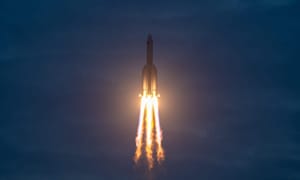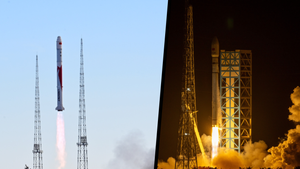
Feb 24, 2024
China names its new crewed spacecraft!
Early on the 24th of February, the China Manned Space Engineering Office announced that it had selected the names for its two spacecraft that will be used for its crewed lunar exploration program. The applications had been open since August and ran until late 2023 with over two-thousand submissions received!
The crewed spacecraft that will stay in orbit has been named Mengzhou (梦舟), or Dream Vessel in English. According to the China Manned Space Agency, the name represents China's dream of landing on the moon to embark on a new journey of space adventures. Reportedly the two versions of Mengzhou will be denoted differently with Mengzhou-Y being the lunar spacecraft variant. The 'zhou' part of the name also continues the nomenclature from the Shenzhou and Tianzhou spacecraft.
The lunar lander spacecraft that will transport crews to the surface has been named Lanyue (揽月), or Grasping for the Moon in English. The spacecraft is named after a poem Chairman Mao Zedong wrote in 1965 according to the China Manned Space Agency.
The poem, Reascending Chingkangshan, the name comes from reads as follows:
I have long aspired to reach for the clouds
And I again ascend Chingkangshan.
Coming from afar to view our old haunt, I find new scenes replacing the old.
Everywhere orioles sing, swallows dart,
Streams babble
And the road mounts skyward.
Once Huangyangchieh is passed
No other perilous place calls for a glance.
Wind and thunder are stirring,
Flags and banners are flying
Wherever men live.
Thirty-eight years are fled
With a mere snap of the fingers.
We can clasp the moon in the Ninth Heaven
And seize turtles deep down in the Five Seas:
We'll return amid triumphant song and laughter.
Nothing is hard in this world
If you dare to scale the heights.
According to the China National Space Administration and China Manned Space Agency, the first crewed mission to the lunar surface will take place before 2030.
So what is Mengzhou?

The Mengzhou spacecraft is China's in-development crewed spacecraft for low Earth orbit and lunar orbit operations. The spacecraft is believed to be able to carry up to seven taikonauts to low Earth orbit or three taikonauts to lunar orbit.
The spacecraft will have two large solar panels to power its systems and life support for the crew. The spacecraft is believed to weigh 26,000 kilograms fully fuelled for a lunar mission. It is currently unknown what changes will be made for the low Earth orbit version of the Mengzhou spacecraft.
The Mengzhou spacecraft consists of a command module, to house the crew, and a service module, to power the spacecraft and allow it to enter lunar orbit.
And what is Lanyue?

The Lanyue spacecraft is China's in-development lunar lander spacecraft for lunar landing missions. The spacecraft will be able to carry two taikonauts to and from the lunar surface in its current design.
The spacecraft will have two large circular solar panels to power its systems and life support for the crew. The spacecraft is believed to weigh 26,000 kilograms fully fuelled with its propulsion module.
The Lanyue spacecraft consists of a lander module, to perform lunar landings and house the crew for their mission, and the propulsion module, which will allow the spacecraft to enter lunar orbit.
What does China's Moon mission look like?
The mission is widely believed to take place in 2029 to coincide with the 80th anniversary of the founding of the People's Republic of China, which occurred on the 1st of October 1949. The mission plan for the crewed landing is believed to be as follows:
The first Long March 10 will take off from the Wenchang Space Launch Site carrying the Lanyue spacecraft to a trans-lunar trajectory. After the Long March 10 completes the trans-lunar burn the spacecraft will separate and spend the next few days flying towards the Moon.
Once near the Moon the Lanyue spacecraft will light its propulsion modules engine to enter orbit of the Moon. The spacecraft will then wait in lunar orbit for the Mengzhou spacecraft.
A few days later a second Long March 10 will take off from the Wenchang Space Launch Site carrying three crew taikonauts aboard the Mengzhou spacecraft to a trans-lunar trajectory. After the Long March 10 completes the trans-lunar burn, the spacecraft will fly towards the Moon over the next few days.
Once the Mengzhou spacecraft is near the moon it will light its engines to enter orbit of the Moon. The spacecraft will then rendezvous with the Lanyue spacecraft in orbit. After rendezvous, the two spacecraft will dock allowing the crew to move between the two spacecraft.
After checkouts of the two spacecraft are completed in lunar orbit the two spacecraft will undock with two crew being headed for the surface and one remaining on orbit. It is believed the propulsion module will still be attached to the Lanyue spacecraft and will perform its final burn to send the spacecraft bound for the surface.
After a predetermined coast phase, the Lanyue spacecraft will separate from the propulsion module and light its engines for landing. The exact landing profile is unknown but it is likely to be similar to the Lunar Module of the Apollo program.
Once the Lanyue spacecraft has confirmed its engines shut off and has soft contact with the lunar surface the crew will prepare to exit the spacecraft. The two taikonauts will exit the spacecraft a few hours after the landing.

The two taikonauts will spend a believed eight hours outside on the lunar surface gathering various samples and deploying science equipment, including a rover to traverse large distances. After spending up to eight hours outside the two taikonauts will board the Lanyue spacecraft and safely store the gathered samples.
Once the two taikonauts are prepared to leave the lunar surface the Lanyue spacecraft will relight its engines and return to lunar orbit where it will rendezvous with the Mengzhou spacecraft. The two spacecraft will once again dock where the crew will transfer themselves and lunar samples out of the lander.
After the samples are removed from the Lanyue spacecraft and any planned cargo is transferred between the two spacecraft they will undock for the second and final time. The Mengzhou spacecraft will then move to a safe distance away before it lights its engines again to carry the three taikonauts aboard on a trajectory back to Earth.
The three crew members will then spend a few days inside the 'Mengzhou spacecraft as it travels back to Earth.
At a predetermined point before entry into Earth's atmosphere, the capsule of the Mengzhou spacecraft will separate from its service module and orient itself for entry. Once through the heat of entry into Earth's atmosphere at speeds of over 11,000 meters a second, or roughly 24,500 miles per hour, the capsule will deploy its parachutes to either touchdown on land or splashdown at sea for recovery of the three taikonauts and the lunar samples.
Once the crew is recovered safely the mission is complete.
A full breakdown of publically available information on China's lunar mission is available here. (The article was written in January 2024 so some information may be outdated)



